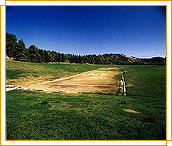Equipment used in running
The running contests were held at the Stadium, the length of which varied from city to city since the foot, the measuring unit, differed from place to place.  For example the Stadium in Olympia was 192,28 ft long, in Delphi 177 ft and in Athens 184,96 ft. A flat area near hills or slopes was the most common location for the construction of a Stadium. Straight lines drawn on the ground originally defined the starting and finishing line of the track. In the 5th century BC, the lines were replaced by a special starting line, which consisted of long permanent stone slabs bearing two parallel incisions. The runners' positions were separated with poles placed in cavities. For example the Stadium in Olympia was 192,28 ft long, in Delphi 177 ft and in Athens 184,96 ft. A flat area near hills or slopes was the most common location for the construction of a Stadium. Straight lines drawn on the ground originally defined the starting and finishing line of the track. In the 5th century BC, the lines were replaced by a special starting line, which consisted of long permanent stone slabs bearing two parallel incisions. The runners' positions were separated with poles placed in cavities.
In the late Classic period, the Greeks invented the hysplyx, which was based on the catapult's mechanism. This was considered as great innovation in running contests since it guaranteed the simultaneous start-off for all the athletes, preventing any kind of discrimination from the judges. If the athletes competed in distances greater than that of a stadium, the turning point was defined by a pole or a small column called kampter.
The runners originally wore a piece of cloth around their waist. In later years the cloth was removed and the runners competed naked. The only exception was the hoplite race (race in full armor) during which the athletes wore helmets, breast-plates and carried shields. In the 5th century BC, the breast-plates were removed and when the helmet was also removed in the 4th century BC the runners ran holding only their heavy wooden, bronze-embedded shield.
|
